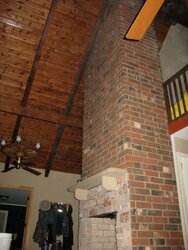I've been thinking again, always a dangerous avocation. Our Fireview works pretty well to heat our 1900 square foot two-story contemporary, but it doesn't really make it HOT the way I expected it would. Saying we have 1900 square feet isn't the whole story, though. The house is a Lindal Cedar passive solar design with a massive southside greatroom/dining room rising up to a gambrel ceiling 25 feet above the floor. Two second-floor bedrooms open onto a loft balcony overlooking that space, which also contains a 12' X 2' X 25' bluestone 4-flue chimney chase (solar mass, dontcha know). Theoretically, if we wanted to open a hostel, we could put two more floor levels over the Greatroom, with 8' ceilings for each one. That would add up to probably 2800 square feet of living area but I am too lazy to calculate all the cubic feet in the house, what with triangular prism shapes and trapezoids, and high sloping ceilings upstairs, etc. It seems much bigger than the supposed 1900 square feet, anyway. I am thinking that this is why the Fireview doesn't heat to the max.
Anyway, I was wondering why we calculate square footage of floor space for heating needs, rather than looking at heated volume of air to be heated. I guess there is an implicit assumption that the ceiling heights are 8 feet for the standard square footage. But I'd like to hear people's thoughts about sizing stoves by volume of heated area rather than what I am thinking now is inaccurate room area.
Especially interested in thoughts from Woodstock along these lines, as I know they are active in this forum.
Thanks for reading!
herb
Anyway, I was wondering why we calculate square footage of floor space for heating needs, rather than looking at heated volume of air to be heated. I guess there is an implicit assumption that the ceiling heights are 8 feet for the standard square footage. But I'd like to hear people's thoughts about sizing stoves by volume of heated area rather than what I am thinking now is inaccurate room area.
Especially interested in thoughts from Woodstock along these lines, as I know they are active in this forum.
Thanks for reading!
herb



